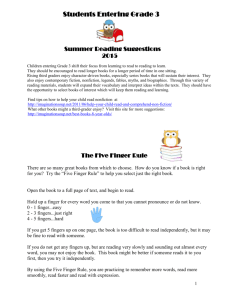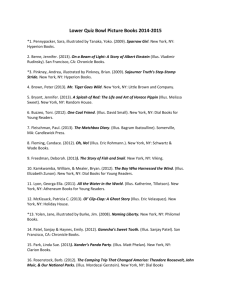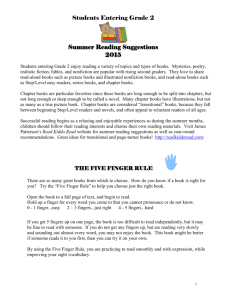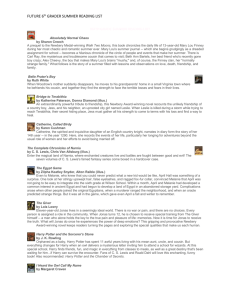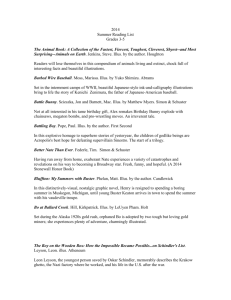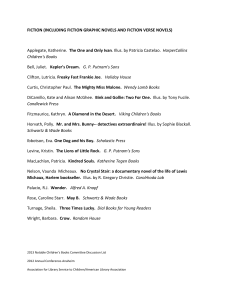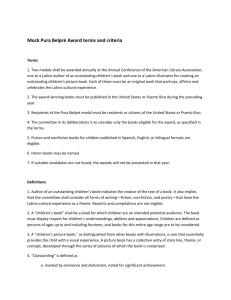Recommended Picturebooks to Help Young
advertisement
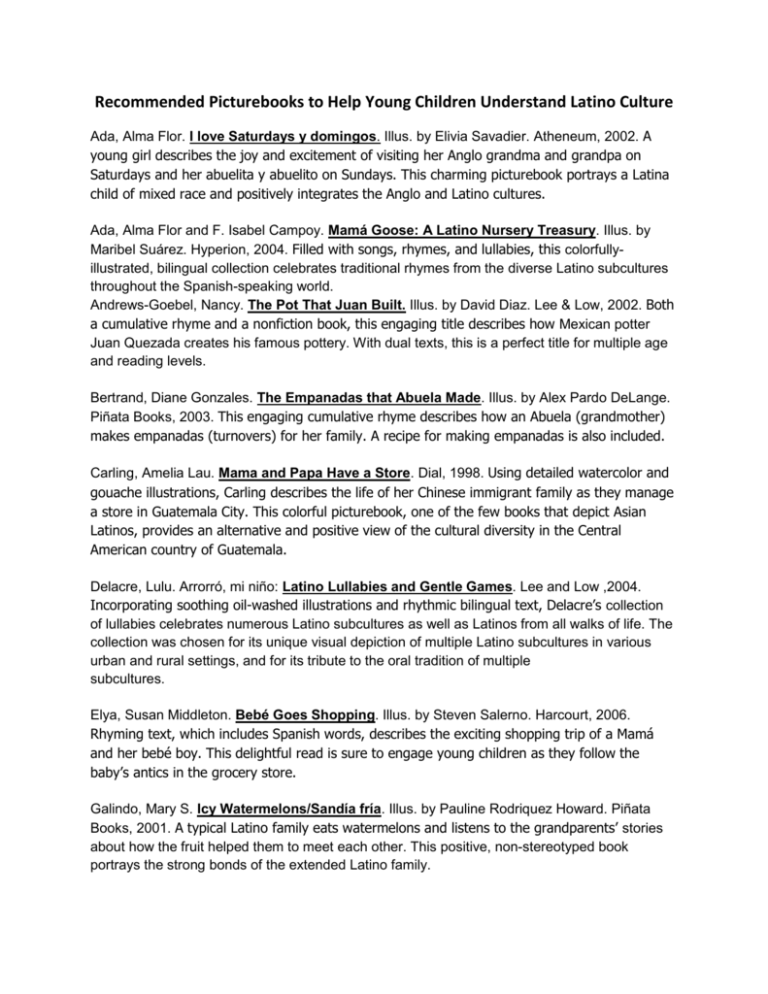
Recommended Picturebooks to Help Young Children Understand Latino Culture Ada, Alma Flor. I love Saturdays y domingos. Illus. by Elivia Savadier. Atheneum, 2002. A young girl describes the joy and excitement of visiting her Anglo grandma and grandpa on Saturdays and her abuelita y abuelito on Sundays. This charming picturebook portrays a Latina child of mixed race and positively integrates the Anglo and Latino cultures. Ada, Alma Flor and F. Isabel Campoy. Mamá Goose: A Latino Nursery Treasury. Illus. by Maribel Suárez. Hyperion, 2004. Filled with songs, rhymes, and lullabies, this colorfullyillustrated, bilingual collection celebrates traditional rhymes from the diverse Latino subcultures throughout the Spanish-speaking world. Andrews-Goebel, Nancy. The Pot That Juan Built. Illus. by David Diaz. Lee & Low, 2002. Both a cumulative rhyme and a nonfiction book, this engaging title describes how Mexican potter Juan Quezada creates his famous pottery. With dual texts, this is a perfect title for multiple age and reading levels. Bertrand, Diane Gonzales. The Empanadas that Abuela Made. Illus. by Alex Pardo DeLange. Piñata Books, 2003. This engaging cumulative rhyme describes how an Abuela (grandmother) makes empanadas (turnovers) for her family. A recipe for making empanadas is also included. Carling, Amelia Lau. Mama and Papa Have a Store. Dial, 1998. Using detailed watercolor and gouache illustrations, Carling describes the life of her Chinese immigrant family as they manage a store in Guatemala City. This colorful picturebook, one of the few books that depict Asian Latinos, provides an alternative and positive view of the cultural diversity in the Central American country of Guatemala. Delacre, Lulu. Arrorró, mi niño: Latino Lullabies and Gentle Games. Lee and Low ,2004. Incorporating soothing oil-washed illustrations and rhythmic bilingual text, Delacre’s collection of lullabies celebrates numerous Latino subcultures as well as Latinos from all walks of life. The collection was chosen for its unique visual depiction of multiple Latino subcultures in various urban and rural settings, and for its tribute to the oral tradition of multiple subcultures. Elya, Susan Middleton. Bebé Goes Shopping. Illus. by Steven Salerno. Harcourt, 2006. Rhyming text, which includes Spanish words, describes the exciting shopping trip of a Mamá and her bebé boy. This delightful read is sure to engage young children as they follow the baby’s antics in the grocery store. Galindo, Mary S. Icy Watermelons/Sandía fría. Illus. by Pauline Rodriquez Howard. Piñata Books, 2001. A typical Latino family eats watermelons and listens to the grandparents’ stories about how the fruit helped them to meet each other. This positive, non-stereotyped book portrays the strong bonds of the extended Latino family. Gonzalez, Lucía. The Storyteller's Candle / La velita de los cuentos . Illus. by LuluDelacre. Children’s Book Press, 2008. Historical picture book that lovingly describes how Puerto Rican Children’s Librarian and Storyteller, Pura Belpré invited new immigrants into the New York Public Library using programming related to the Three Kings’ Day. Gonzalez, Maya Christina. My Colors, My World / Mis colores, mi mundo. Children’s Book Press, 2007. Although she lives in a brown sandy desert, a little girl named Maya is able to see the beautiful colors around her. This gorgeously-illustrated bilingual picturebook, which teaches colors in English and Spanish, is highly recommended for use in early childhood programs. Guy, Ginger Foglesson. My Grandma/Mi Abuelita. Illus. by Vivi Escrivá. Rayo, 2007. Simple bilingual text and colorful illustrations engage young children as they trail a father and his two children on their visit to see their Abuelita. Herrera, Juan Felipe. The Upside Down Boy/El nino de cabeza. Illus. by Elizabeth Gomez. Children’s Book Press, 2000. This vibrant story describes Juanito’s transition as a new immigrant into the American school system. Bold illustrations exude magical realism and invite young readers into the well-crafted story familiar to Latino immigrant students. Keep, Richard. Clatter Bash! A Day of the Dead Celebration. Peachtree, 2004. Vibrant illustrations and simple text make this book perfect for sharing the Mexican holiday El Dia de los Muertos with young children. A simple explanation of the holiday is also provided in the author’s notes. Mora, Pat. A Birthday Basket For Tia. Illus. by Cecily Lang. Simon & Schuster, 1992. Young Cecilia prepares for her 90-year-old Tia’s (Aunt’s) birthday party but has trouble deciding the perfect gift for her special relative. Mora, Pat. Uno, Dos, Tres; One, Two, Three. Illus. by Barbara Lavallee. Clarion, 1996. Through rhyming text and bold illustrations, readers follow two little girls as they count to ten in English and Spanish while searching for a birthday present for their Mamá. Morales, Yuyi. Just a Minute: A Trickster Tale and Counting Book. Chronicle, 2003. As Grandma Beetle prepares for a birthday party, she is visited by Señor Calavera (Death) who tells her it is time to go. Through a series of excuses that involve counting in Spanish and English, the clever grandma outwits death and enjoys a spectacular day with her grandchildren. Orozco, José-Luis. Diez Deditos/Ten Little Fingers and Other Play Rhymes and Action Songs from Latin America. Illus. by Elisa Kleven. Dutton Children’s Books, 1997. This vibrantly illustrated bilingual collection of songs and finger rhymes are a perfect way to integrate music from the Latino cultures into the early childhood classroom. An accompanying CD is available for those who do not speak Spanish or can not carry a tune. Pérez, Amada Irma. My Diary from Here to There. Illus. by Maya Christina Gonzalez. Children's Book Press, 2002. In this bilingual book with vibrant illustrations that seem to burst from the page, a young Mexican girl describes her excitement and fears as her family immigrates into the United States from Mexico. This vivid picturebook, which is an autobiographical account of Pérez’s own immigration experience, authentically and accurately portrays the Mexican immigration experience into the U.S. Pinkney, Sandra. I am Latino: The Beauty in Me. Illus. by Myles Pinkney, 2007. Using vibrant photos, this appealing nonfiction title celebrates various facets of the Latino culture and encourages children to recognize the beauty in diversity. Ramírez, José. Quinito’s Neighborhood / El vecindario de Quinito. Illus. by Ina Cumpiano. Children's Book Press, 2005. Chosen for its representation of gender diversity in the generic Latino culture, this simple bilingual picturebook describes the various occupations of a young boy’s relatives and neighbors. Women are presented in traditional male occupations such as a carpenter and a truck driver, while men are depicted in traditional female roles such as a nurse and an elementary school teacher. In addition, the bold acrylic illustrations exude the warmth of Quinito’s neighborhood. Weeks, Sarah. Counting Ovejas. Illus. by David Diaz. Atheneum, 2006. When a small child has trouble falling asleep, he decides to count sheep. Unfortunately, he spends most of the night trying to get all of the rainbow- colored sheep out of his bedroom. Bilingual text introduces colors in Spanish and English and includes pronunciation guides directly below each Spanish word. Wonderful book for circle time or bedtime!
